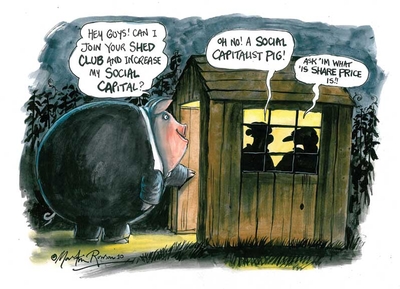 Do you sing in a choir? Train your daughter’s football team? Belong to a residents’ association? Participate in Neighbourhood Watch? Enjoy regular coffee mornings? Well done. You possess a vitally important commodity. You have social capital.
Do you sing in a choir? Train your daughter’s football team? Belong to a residents’ association? Participate in Neighbourhood Watch? Enjoy regular coffee mornings? Well done. You possess a vitally important commodity. You have social capital.
In the past two decades academics and politicians have fallen over themselves in their rush to embrace this new concept. Its leading academic proponent, Robert Putnam, whose 1995 essay “Bowling Alone: America’s Declining Social Capital” became a bestselling book, was reputedly the single most cited author across the social sciences in the 1990s, granted audiences with US Presidents Clinton and Bush, and with Prime Minister Blair (who set up a “social capital unit” in his cabinet office).
And yet social capital remains a distinctly nebulous idea. Derived from the cliché that it’s not what you know but who you know that counts, it focuses on the importance of cultivating connections between people. The more connections you have the better your life will be. But that doesn’t really get you very far. What, for example, if you happen to know the wrong people or get into the wrong crowd? Then you would acquire what is known as dark, perverse or negative social capital: think Ku Klux Klan, the Mafia or fascism.
But even if we stay with the more positive aspects of social capital, its definition still wobbles. Does it apply to anyone you know and how you know them? The notion is so flexible that it can be used to incorporate almost any individual or social connection, attribute, belief or activity. It can include organisations or groups you belong to; those you trust, from neighbours through police to politicians; and it could encompass the whole range of acquaintances – family, friends, colleagues, babysitting circles, fellow bowlers. Literally hundreds of variables have been used to define and measure social capital, ranging from the mundane (two-parent family or not) to the exotic (whether you own a pet or the colour of your skin) and the bizarre (the imaginary social capital you have with characters in soaps).
In this way, social capital has come to occupy, even to displace, more traditional notions of community and civil society. Its proponents tend to avoid anything to do with those other great structures of modern society, the state and the market, although performance within and across these is deemed to be enhanced by higher levels of social capital. This is itself indicative of the extent to which social capital has come to be perceived as a cure-all, both for personal well-being and for the wider society. And this can lead to some dangerous assumptions. For example, the World Bank has heavily promoted social capital as the “missing link” in development, drawing on a study of Tanzanian villages which purported to show that joining a burial society was six times more important for poverty alleviation than female education.
Putnam has even suggested that going out and joining an association – of birdwatchers, say, or a camera club – will be better for your life-expectancy than giving up smoking. Acquisition of social capital has been claimed to improve your mental health, help you to give up binge drinking and, if you have enough of it, you’ll avoid coronary heart disease, cancer, obesity, teen pregnancy, accidents, suicide, violence, crime and “risky” pre-marital sexual activity. Social capital will enhance life satisfaction and well-being, help alleviate depression in mothers of young children and can influence such diverse hazards as low birth weight, drug addiction and tooth decay!
And it’s not just your health that can be affected by social capital, according to its advocates. It will give you huge advantages in all other areas of economic and social life, whether directly or as spin-offs from other activities – fellow choir-members can become lucrative contracts. Rationalists may well raise an eyebrow at these somewhat grandiose claims. Where, you might ask, is the evidence? How do you distinguish cause and effect, or take into account any number of other considerations?
Given the difficulties in proving any of these benefits, the idea of social capital seems more like a faith than a philosophy. So what can possibly explain its current extraordinary popularity and its rise to prominence over the past 20 years? Its appeal seems to combine two apparently conflicting values. In one sense, it appears to make the genuinely humanist assumption that the world would be a better place if individuals and communities could bond, bridge and – in the jargon of social capital – “link” with one another. At the same time, in a more market-driven approach, it implies that those who acquire social capital will do better for themselves, and others around them. So social capital is the ethos of self-help raised to some level of the collective from which all benefit. Of course, church-going, like membership of bowling clubs, has declined, creating anxiety about the fate of our sense of community. In some respects, social capital talk is a response to this decline, almost a substitute for religion. Belief in its benefits fills the gap previously occupied by religious community and a belief in God. Unsurprisingly, there is a significant literature on religion as a form of social capital.
A further aspect of the marriage between humanism and social capital concerns the vogueish notion of philanthrocapitalism. This itself has two elements. One is the familiar notion of corporate responsibility: why not make money and be good at the same time? The other is to see charitable activity literally as a form of capital. If you have the potential to raise money, you can turn it into a financial asset that you sell to somebody now for a capital sum so that it is already available for charitable purposes, and your purchaser gets the income when it comes in. In other words, let’s mortgage charity!
This is indicative of where finance has brought us over the past few decades. But it also points to major problems with the whole social capital enterprise. For, while in principle it can range over almost everything, it has a number of no-go areas. Foremost of these is the economy itself. Social capital adherents either ignore the topic altogether or else maintain vaguely that economic gain will somehow be a natural result. They have even less to say about the world of high finance.
Social capital is supposed to prosper in, and lead to, greater equality. Its boosters suggest building social capital will increase equality, and its decline is responsible for widening gaps and social dislocation. But if we look at America we see that in the last 40 years the share of the top one per cent of earners has gone from well under ten per cent to well over 20 per cent, reversing the previous trend. Surely this has more to do with the decline of US civil society, manufacturing, labour movements and inadequate welfare than the demise of bowling? Is it perhaps too inconvenient to entertain the possibility that elites have more social capital than the poor because they’ve got more money, power and influence, rather than the other way round?
And what of policy itself? Despite all the hype and government-sponsored research to measure social capital, I know of no example of the concerted and successful use of social capital in creating policies. Instead, something much more sinister is at work. Governments who have already more or less decided what policy is to be implemented will use social capital to legitimise their aims. This has been true, for example, of World Bank policy in removing indigenous populations to allow for mining projects. And large-scale mining companies have been deliberately and selectively building what they themselves call social capital with communities in order to be able to gain resource extraction permissions more fully and more quickly.
Closer to home, social-capital-speak has been deployed to pave the way for cuts in resources, creating a patina of “democratic” participation, and shifting the responsibility for cuts on to those who will suffer most from them (Cameron’s Big Society initiative carries more than a whiff of social capitalese). In this respect, social capitalism is merely a feeble response to, if not a collaborator in, the neoliberal project of promoting the market in general and finance in particular. And it’s worth remembering that social capital has origins in neoliberal thinking, whose core aim is to shape communities in favour of markets.
So social capital parasitically feeds upon, and in the process discredits, established social science, which has traditionally been more critical, penetrating and targeted in its understanding of inequality. Social capital theory degrades, homogenises and idealises whatever it touches. It is the romantic, part-nostalgic and blinkered belief that each of us could do better if only we would work together, thereby side-stepping systematic unfairness and its impact on those who are now supposed to overcome economic and social disadvantage by networking, volunteering, linking, and bloody well improving themselves.
Ben Fine's new book is Theories of Social Capital: Researchers Behaving Badly (Pluto Press)
This piece is from the September/October 2010 issue of New Humanist. subscribe

